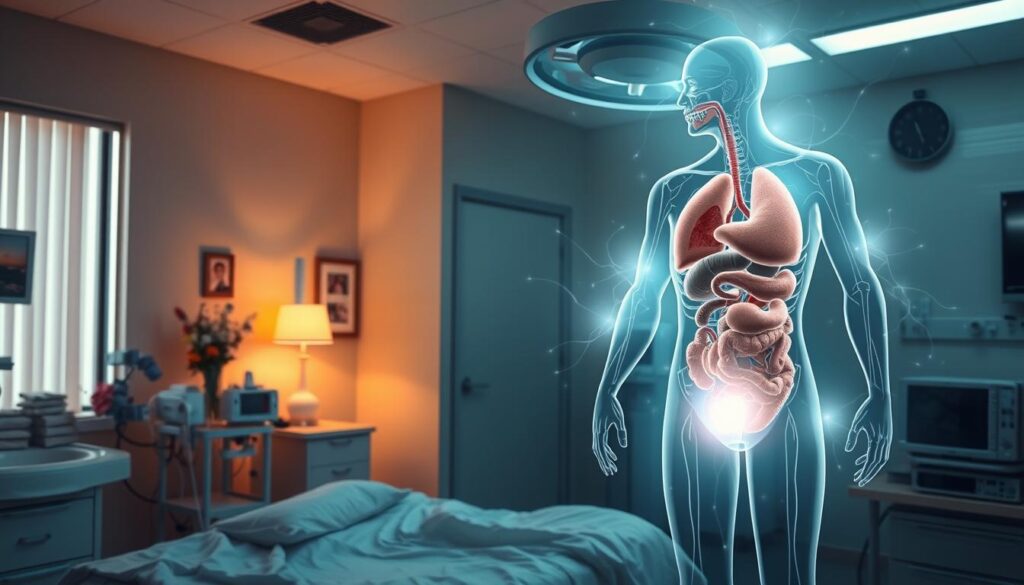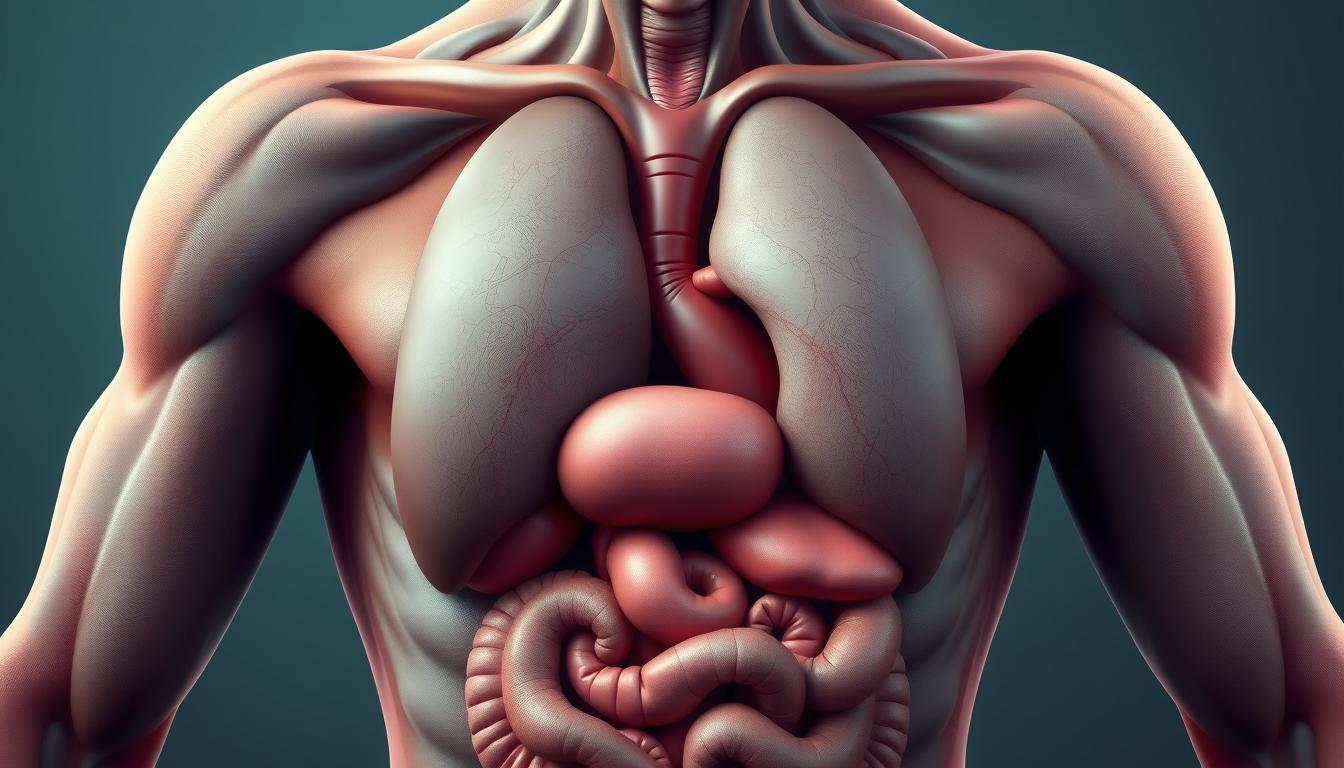Fighting cancer can lead to big medical choices. A woman had eight organs removed to fight cancer. This shows how serious cancer treatment can be.
Getting a cancer diagnosis is very hard. The surgery to treat it is even harder. It shows the fight against a rare cancer called pseudomyxoma peritonei (PMP).
Her story helps us understand cancer treatment better. It shows the importance of early detection and support for patients.
Key Takeaways
- A woman underwent a complex surgical procedure resulting in eight organ removals due to cancer.
- The surgery addressed complications from pseudomyxoma peritonei (PMP), a rare form of cancer.
- Awareness of cancer symptoms is vital, specially for young individuals.
- Faye supports Cancer Research UK’s initiatives, highlighting the importance of community action in cancer research.
- The advancements in cancer treatment give hope through the increasing number of approved therapeutics.
- Public participation in cancer research events helps improve survival rates for cancer patients.
Understanding Pseudomyxoma Peritonei (PMP)
Pseudomyxoma peritonei, or PMP, is a rare condition. It has mucinous tumors in the peritoneal cavity. This can cause big health problems and is hard to treat.
It’s important to know about PMP. This helps find the best treatments, like surgery.
What is Pseudomyxoma Peritonei?
PMP is when mucus builds up in the belly. It usually comes from a tumor in the appendix. It might not be found early, but it needs quick action.
Studies say PMP happens in 2 to 4 people per million. Women are more likely to get it. Symptoms include a big belly, pain, and changes in bowel movements.
Causes and Risk Factors
PMP often comes from certain risks. People with appendiceal tumors or who had appendicitis surgery are at higher risk. KRAS gene mutations are common in PMP, at about 77.8%.
Doctors need to know these risks. This helps find PMP early. It also helps plan better treatments and surgeries.
| Incidence | Cancer Surgery Impact | 5-Year Survival Rate |
|---|---|---|
| 2-4 cases per million | Improvement via CRS-HIPEC | 50% – 100% |
| More than 50% presented early | Treatment-related morbidity: 12% – 67.6% | 10-Year Survival Rate: 10% – 30% |
Woman had eight organs removed in cancer treatment
A woman with pseudomyxoma peritonei (PMP) shows how fast action is key. She went to the hospital many times, worried about her belly pain and swelling. It took a while to find out what was wrong.
The Journey to Diagnosis
Doctors used an ultrasound and CT scan to find out what was happening. They found a rare and fast-growing cancer. She had to have eight organs taken out in a long surgery.
Initial Symptoms and Hospital Visits
Her symptoms were important to notice. She had:
- Abdominal pain and discomfort
- Unexplained weight changes
- Nausea and bloating
- Changes in bowel habits
These signs are easy to miss. But with the right care, she got treated. She had a big surgery in November 2023. Now, doctors watch her closely for any signs of cancer coming back.

The Surgical Procedure: “The Mother of All Surgeries”
Going through cancer treatment can lead to complex surgeries. One such surgery is called “the mother of all surgeries.” It involves removing many organs to fight cancer. Surgeons work hard to make this complex surgery a success.
Overview of Multi-Organ Surgery for Cancer
Multi-organ surgery for cancer is a big deal. It aims to get rid of cancer in many parts of the body. Faye Louise, a model and flight dispatcher, had eight organs removed in this surgery.
The surgery lasted about eleven hours. A team of experts worked together to make it happen. After the surgery, Faye found out she was cancer-free. She now gets scans every year to check for cancer again.
Organs Involved in the Surgery
This surgery touched many important organs:
- Appendix
- Part of the liver
- Spleen
- Gallbladder
- Ovaries
- Uterus
- Fallopian tubes
- Greater and lesser omentum
- Part of the bowel
- Scraped diaphragm
- Scraped pelvis
This surgery is very challenging for both patients and the surgical team. Faye’s surgery greatly improved her chances of getting better. After surgery, the recovery journey starts. It’s filled with emotional and physical challenges that need strength and support.
The Importance of Early Detection
Finding cancer early makes treatment more likely to work. Early detection lets doctors act fast, helping patients more. Knowing the signs of cancer can help find problems like Pseudomyxoma Peritonei (PMP) sooner.
Being aware of these signs helps people get medical help early. This is key to stopping cancer from getting worse.
Signs and Symptoms to Watch For
Keep an eye out for cancer signs. Early signs might be small but are very important. Look for:
- Unexplained weight loss
- Persistent abdominal pain or swelling
- Changes in bowel or bladder habits
- Fatigue and weakness
- Changes in skin appearance or texture.
These signs don’t always mean cancer. But if they last, see a doctor, even if you’re not at high risk.
Screening Recommendations for High-Risk Individuals
Screening is key for catching cancer early. It depends on your risk, like family history and age. Here are some tips:
| Type of Cancer | Recommended Age to Begin Screening | Frequency of Screening |
|---|---|---|
| Breast Cancer | Age 40 for average risk; earlier for high risk | Annually |
| Colorectal Cancer | Age 45 for average risk; earlier for high risk | Every 10 years (colonoscopy) |
| Cervical Cancer | Age 21 | Every 3 years (Pap test) |
Following these screening tips can catch cancer early. This means better treatment options. Early detection helps lower death rates and improves chances of recovery.
Cancer Treatment Options Beyond Surgery
There are many ways to treat cancer that don’t involve surgery. These methods help patients live longer and feel better. They include chemotherapy, immunotherapy, and targeted therapies.
Learning about these options helps patients and their families make good choices. It’s important for their care.
Advanced Cancer Treatment Techniques
New ways to treat cancer are being found all the time. They focus on treating each person as an individual. For example, Stage IA1 treatment depends on how far the cancer has spread.
Doctors might use cone biopsies or radical trachelectomy to save fertility. If not, they might choose simpler surgeries. As cancer gets worse, treatments get more complex.
For Stage IIB and later, treatments often include drugs and radiation. This is to fight the cancer more effectively.
Complementary Treatments and Supportive Care
Supportive care is a big part of treating cancer. It includes things like psychological support and good nutrition. These help patients recover better.
In some cases, treatment plans change based on the patient’s situation. This is true for cervical cancer during pregnancy. Decisions are made based on the cancer and how far along the pregnancy is.
Doctors also try new treatments and join clinical trials. This helps improve care for everyone. It’s a whole approach that looks at the body and mind.
Recovery After Organ Removal Surgery
Recovering from major organ removal surgery is tough. It’s even harder when it’s for cancer. Patients face many physical and emotional challenges. Knowing about these helps them heal better.
Everyone’s recovery is different. But, having support and resources makes a big difference. They help patients get back to their daily lives.
Physical and Emotional Challenges
Recovering from cancer surgery is hard. Patients face many challenges, like:
- Pain Management: Pain is common after surgery. Finding the right way to manage it is key.
- Lifestyle Adjustments: Surgery can change how you live. You might need to eat differently or move less.
- Mental Health: Surgery can also affect your mind. Anxiety and depression are common. Getting help for your mental health is very important.
Support Systems and Rehabilitation Resources
Having a strong support system helps a lot. Important resources include:
- Healthcare Professionals: Doctors, nurses, and therapists are there to help. They guide you through recovery.
- Counseling Services: Mental health experts help with emotional issues. They teach healthy ways to deal with feelings.
- Community Resources: Local groups let you meet others who understand. It’s a place to share and feel connected.
| Type of Support | Description |
|---|---|
| Healthcare Team | Doctors, nurses, and therapists work together to help you heal. |
| Counseling | Experts help you deal with your feelings and find healthy ways to cope. |
| Support Groups | Places where you can share your story and get support from others. |
Conclusion
A woman who had eight organs removed for cancer shows the risks and benefits of such treatments. It’s important to know about cancer and its symptoms early. This helps in fighting the disease better.
Her story is not just about fighting cancer. It’s about her strength and courage. Stories like hers inspire many. They push us to learn more about cancer and find new ways to treat it.
Even though some cancers have a good survival rate, many still face tough futures. We need to keep learning and helping each other. This way, we can improve treatments and help more people recover.


